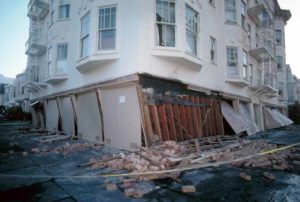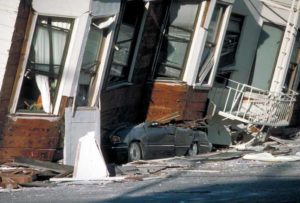
Thirty years after Loma Prieta, the Bay Area is better prepared for earthquakes, but there’s still much to be done.
October 17, 2019 marks the 30-year anniversary of the Loma Prieta earthquake. Triggered by a slip along the San Andreas Fault in the Santa Cruz Mountains, the 6.9 temblor was the largest to hit the San Francisco Bay Area since the infamous 1906 quake. While the shaking lasted a mere 15 seconds, it was more than enough time to unleash a volley of catastrophic effects. In the end, the earthquake took 63 lives and caused nearly 4,000 injuries, along with more than $6 billion ($13 billion in today’s money) in damage to infrastructure and property.
While the Loma Prieta earthquake will forever be remembered as a tragedy, the event nonetheless had at least one positive effect. By revealing the region’s vulnerability to earthquakes, it spurred legislative, scientific, and private organizations to pursue knowledge and implement preparatory measures. Today, the Bay Area is better prepared for a major earthquake than ever before.
Here are some examples of advancements in earthquake preparedness made over the past three decades:
Improved building code standards
Since 1989, California building code standards have been revised with a focus on earthquake safety. Applied both to new construction and existing infrastructure, the updated code helps ensure the Bay Area’s buildings, roadways and crucial systems are equipped to withstand future quakes.

The lack of adequate shear walls on the garage level exacerbated damage to this building at the corner of Beach and Divisadero streets in the Marina District of San Francisco. Photo: J.K. Nakata, U.S. Geological Survey
Large-scale examples of the new standards in action include the seismic retrofitting measures applied to the Bay Bridge and the Hetch Hetchy Regional Water System (the latter of which supplies water to 2.6 million Bay Area residents). Hundreds of structures have also been brought up to code, including hospitals, government buildings and schools. Furthermore, in 2013, the City of San Francisco passed legislation that requires evaluation and retrofitting of multiunit “soft story” buildings built prior to 1978. These are generally wood-frame structures whose base level lacks sheer bracing to properly support the upper stories—a design flaw that caused many such buildings to collapse during the Loma Prieta earthquake.
In addition to improving existing infrastructure, the updated building code ensures new construction is built in a way that maximizes earthquake resilience. One example of this is 181 Fremont in Downtown San Francisco, a 70-story skyscraper completed in May 2018. ARUP awarded developer Jay Paul Company a REDi Gold rating due to the building’s superior seismic design and construction.
Advancements in earthquake research and applied science
In the science field, the Loma Prieta earthquake inspired a renaissance of earthquake research and technology. During the consequent decades, the U.S. Geological Survey (USGS) has made great strides in understanding earthquake causes, effects, and warning signs by examining and monitoring the many fault lines that intersect California. These efforts have culminated in the development of ShakeAlert, the first earthquake early warning system in the United States.
ShakeAlert utilizes hundreds of ground motion sensors installed along the West Coast to quickly detect and assess seismic activity. In the event of a large earthquake, the system’s goal is to provide advance warning to Bay Area residents and authorities so they can act before it strikes their area. Studies have shown that the warning time would range from a few seconds to tens of seconds. Eventually, the system could be used to automatically initiate safety actions such as halting transit systems and shutting off gas lines to prevent fires. It’s still being tested as of March 2019, but USGS officials expect ShakeAlert to be fully operational within the next several years.
Improved emergency response network

An automobile lies crushed under the third story of this apartment building in the Marina District. Photo: J.K. Nakata, U.S. Geological Survey
Besides revealing construction deficiencies, the Loma Prieta earthquake highlighted the need for more robust emergency response management. As a result, San Francisco took major steps to overhaul its emergency response plan, with a focus on earthquake-specific measures. In addition to consolidating its Department of Emergency Management (DEM) and relocating it to a seismically reinforced headquarters, the City implemented programs such as AlertSF, a notification system that provides residents and visitors with emergency and post-disaster information via text and email. The DEM is also taking advantage of social media outlets like Twitter to further expand its reach in broadcasting emergency communications.
The Loma Prieta earthquake also inspired the formation and consolidation of private emergency response agencies. Most notable is San Francisco Community Agencies Responding to Disaster (SFCARD), a network of nonprofit, faith-based and private humanitarian organizations. In the event of a future quake, the efforts of agencies like DEM and SFCARD will go a long way toward ensuring Bay Area residents have access to the information and relief services they need.
More to be done (and little time to do it)
While these advancements have made the Bay Area better prepared for an earthquake, there’s still more that needs to be done—and the clock is ticking. According to the USGS, there’s a 63% chance of a major seismic event occurring in the Bay Area during the next 30 years, and many experts believe we’re overdue.
The reality is there’s only so much the government and other organizations can do to protect Bay Area residents from the effects of an earthquake. A certain amount of responsibility rests on its residents to individually implement earthquake preparation measures. With this in mind, are you ready for the next “big one”? In the next section, we’ll go over some large- and small-scale measures you can take to prepare your home and family.
Large-scale earthquake preparation measures
Despite updated building code and seismic improvements to existing infrastructure, thousands of structures in the Bay Area still lack recommended seismic reinforcement. The majority of these structures consist of privately owned homes and buildings. Even where such measures have been legally mandated (such as in San Francisco), many property owners have yet to comply. In some cases, this is due to the financial expense of the renovations. Fortunately, there are several financing programs in place to help cover the cost of necessary seismic improvements. These include Property Assessed Clean Energy (PACE), California Capital Access Program (CalCAP) and Earthquake Brace + Bolt (EBB).
For the average home, recommended seismic improvements consist of foundation bolting, bracing of cripple walls (the short wood stud walls enclosing the crawl space beneath the first floor) and reinforcement of ceiling joints. The extent of recommended measures may vary from home to home, so it’s good to get a consultation from a professional contractor. Learn more about residential seismic retrofitting measures.
Another overlooked aspect of earthquake preparedness is insurance. It’s estimated that fewer than 13% of homes are covered by an earthquake insurance policy, along with roughly 10% of commercial buildings. Given the amount of damage a large earthquake can inflict on property, it’s perplexing why so few property owners in California have opted to acquire coverage. To find out if your home is covered (and if not, how to get coverage), contact your insurance company.
Small-scale earthquake preparation measures
Besides large-scale measures like seismic retrofitting and acquiring earthquake insurance, there are several small-scale measures all California residents should implement. First, put together a family emergency response plan so everyone knows what to do when an earthquake (or similar emergency) strikes. Next, prepare an emergency kit that contains food, water, flashlights and a hand-crank radio. Learn more about how to prepare an emergency kit.
Furthermore, there are several DIY steps you can take to increase earthquake safety in your home. Here are a few examples:
- Anchor tall bookshelves and other heavy or high furniture to the walls. Be sure to attach the items to the wall studs rather than the drywall.
- Keep heavy objects on lower shelves—this will keep the bulk of the weight on the bottoms of dressers and bookcases, making them less quick to tip over in an earthquake.
- Secure framed pictures, mirrors and other heavy objects to the walls with closed hooks or earthquake putty.
- Double-check that your gas meter has an automatic safety valve. If it doesn’t, replace it as soon as possible. Gas leaks lead to fires, which are traditionally a major cause of damage in earthquakes.
- Strap your water heater, refrigerator, furnace, and gas appliances to wall studs and bolt them to the floor.
These are just a handful of steps for reducing the risk of injury or death in your home when an earthquake strikes. Read more earthquake preparedness measures.
To find a Diamond Certified building contractor in your area, visit www.diamondcertified.info.
